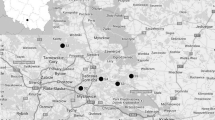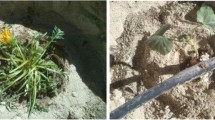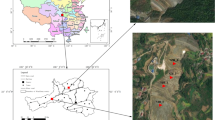Abstract
The area along middle and lower reaches of the Yangtze River is one of the biggest Cu belts in China. In the present study, the metallophytes growing in four copper (Cu)-enriched sites along the Yangtze River were surveyed to get detailed information about vegetation composition and their Cu uptake characteristics. In all sampling sites, Cu concentrations of soils were high; whereas the organic matter, acidity and salinity of most soils were on normal levels. Totally 82 plant species belonging to 45 families were recorded. All the species recorded in the present study exhibited high tolerances for Cu although they differed greatly in their abilities to accumulate Cu. Except for Rumex acetosa and Phytolacca acinosa, most species were Cu-excluders and no Cu hyperaccumulator was found. The Cu translocation factors (TFs) and bioconcentration factors (BCFs) of the 12 dominant species were fairly low, indicating low concentrations of Cu were translocated to the shoots of these species. On this basis, the potential utilization of these metallophytes for phytoremediation was discussed.


Similar content being viewed by others
References
Adriano DC (1986) Trace elements in the terrestrial environment. Springer, New York, 533 pp
Allen SE (1989) Chemical analysis of ecological materials, 2nd edn. Blackwell Scientific Publications, Oxford. 368 pp
Antonovics J, Bradshaw AD, Turner RG (1971) Heavy metal tolerance in plants. Adv Eco Res 7:1–85
Baker AJM (1981) Accumulators and excluders-strategies in the response of plants to heavy metals. J Plant Nutr 3:643–654
Baker AJM, McGrath SP, Sidoli CMD, Reeves RD (1994) The possibility of in situ heavy metal decontamination of polluted soils using crops of metal-accumulating plants. Resour Conserv Recy 11:41–49
Boyd RS (2004) Ecology of metal hyperaccumulation. New Phytol 162:563–567
Bradshaw AD, McNeilly T (1981) Evolution and pollution. Edward Arnold Limited, London, 76 pp
Bradshaw AD (1997) Restoration of mined lands—using natural processes. Ecol Eng 8:255–269
Brooks RR (1998) Plants that hyperaccumulate heavy metals. Wallingford CAB International, New York, p 380
Chang YF, Liu XP, Wu YC (1991) The copper and ore belt in the middle and lower reaches of the Yangtze River. Geology Publishing House, Beijing, p 379 (in Chinese)
Conesa HM, Faz A, Arnaldos R (2006) Heavy metal accumulation and tolerance in plants from mine tailings of the semiarid Cartagena-La Union mining district (SE Spain). Sci Total Environ 366:1–11
Gemmell RP (1977) Colonization of industrial wasteland. Edward Arnold, London, p 75
Jiang LY, Yang XE, He ZL (2004) Growth response and phytoextraction of copper at different levels in soils by Elsholtzia splendens. Chemosphere 55:1179–1187
Lefèbvre C, Vernet P (1990) Microevolutionary processes on contaminated deposites. In: Shaw J (ed) Heavy metal tolerance in plants: evolutionary aspects. CRC, Boca Raton, FL, pp 286–297
Leteinturier B, Baker AJM, Malaisse F (1999) Early stages of natural revegetation of metalliferous mine working in South Central Africa: a preliminary survey. Biotechnol Agron Soc Environ 3(1):28–41
Li MS (2006) Ecological restoration of mineland with particular reference to the metalliferous mine wasteland in China: a review of research and practice. Sci Total Environ 357:38–53
Lindsay WL, Norvell WA (1978) Development of a DTPA test for zinc, iron, manganese, and copper. Soil Sci Soc Am J 42:421–428
Liu XH, Xue Y, Zhou DM, Wu LH, Si YB, Shen ZG, Luo YM (2005) Primary study on copper tolerant plants in mine areas. J Agro-Environ Sci 24:50–54 (in Chinese)
Lou LQ, Shen ZG, Li XD (2004) The copper tolerance mechanisms of Elsholtzia haichowensis, a plant from copper-enriched soils. Environ Exp Bot 51:111–120
Macnair MR (1993) The genetic of metal tolerance in vascular plants. New Phytol 124:541–559
Macnair MR, Tilstone GH, Smith SE (2000) The genetics of metal tolerance and accumulation in higher plants. In: Terry N, Banuelos G (eds) Phytoremediation of contaminated soil and water. Lewis Publishers, FL, pp 235–250
Malaisse F, Baker AJM, Ruelle S (1999) Diversity of plant communities and leaf heavy metal content at Luiswishi copper/cobalt mineralization, Upper Katanga, Dem. Rep. Congo. Biotechnol Agron Soc Environ 3(2):104–114
McGrath SP, Cunliffe CH (1985) A simplified method for the extraction of the metals Fe, Zn, Cu, Ni, Cd, Pb, Cr, Co and Mn from soils and sewage sludges. J Sci Food Agr 36:794–798
McGrath SP, Zhao FJ (2003) Phytoextraction of metals and metalloids from contaminated soils. Curr Opin Biotech 14:277–282
Mingorance MD, Valdé B, Rossini Oliva S (2007) Strategies of heavy metal uptake by plants growing under industrial emissions. Environ Int 33:514–520
Pilon-Smits E (2005) Phytoremediation. Annu Rev Plant Biol 56:15–39
Pauwels M, Willems G, Roosens N, Frérot H, Saumitou-Laprade P (2008) Merging methods in molecular and ecological genetics to study the adaptation of plants to anthropogenic metal-polluted sites: implications for phytoremediation. Mol Ecol 17:108–119
Reeves RD, Baker AJM (2000) Metal-accumulating plants. In: Raskin I, Ensley BD (eds) Phytoremediation of toxic metals: using plants to clean up the environment. Wiley, New York, USA, pp 193–229
Ross SM (1994) Sources and forms of potentially toxic metals in soil-plant systems. In: Ross SM (ed) Toxic metals in soil-plant systems. Wiley, Chichester, UK, pp 3–26
Rotkittikhun P, Kruatrachue M, Chaiyarat R, Ngernsansaruay C, Pokethitiyook P, Paijitprapaporn A, Baker AJM (2006) Uptake and accumulation of lead by plants from the Bo Ngam lead mine area in Thailand. Environ Pollut 144:681–688
Salt DE, Smith RD, Raskin I (1998) Phytoremediation. Annu Rev Plant Biol 49:643–668
Shu WS, Yang KY, Zhang ZQ, Yang B, Lan CY (2001a) Flora and heavy metals in dominant plants growing on an ancient copper spoil heap on Tonglushan in Hubei province, China. Chin J Appl Environ Biol 7:7–12 (in Chinese)
Shu WS, Ye ZH, Lan CY, Zhang ZQ, Wong MH (2001b) Acidification of lead/zinc mine tailings and its effect on heavy metal mobility. Environ Int 26:389–394
Shu WS, Ye ZH, Zhang ZQ, Lan CY, Wong MH (2005) Natural colonization of plants on five Lead/Zinc mine tailings in Southern China. Restor Ecol 13:49–60
Song J, Zhao FJ, Luo YM, McGrath SP, Zhang H (2004) Copper uptake by Elsholtzia splendens and Silene vulgaris and assessment of copper phytoavailability in contaminated soils. Environ Pollut 128:307–315
Tang SR, Wilke BM, Huang CY (1999) The uptake of copper by plants dominantly growing on copper mining spoils along the Yangtze River, the People’s Republic of China. Plant Soil 209:225–232
Walkley A, Black CA (1934) An examination of degradation method for determining soil organic matter: a proposed modification of the chromic acid titration method. Soil Sci 37:29–35
Weng GY, Wu LH, Wang ZQ, Luo YM, Christie P (2005) Copper uptake by four Elsholtzia ecotypes supplied with varying levels of copper in solution culture. Environ Int 31:880–884
Whiting SN, Reeves RD, Richards D et al (2004) Research priorities for conservation of metallophyte biodiversity and their potential for restoration and site remediation. Restor Ecol 12:106–116
Wong MH (2003) Ecological restoration of mine degraded soils, with emphasis on metal contaminated soils. Chemosphere 50:775–780
Xie XJ, Xu BL (1953) Elsholtzia haichowensis: an indicator plant for copper ore. Acta Geologica Sin 32:360–367 (in Chinese)
Zhang MK, Wang LP (2007) Impact of heavy metals pollution on soil organic matter accumulation. Chin J Appl Ecol 18(7):1479–1483 (in Chinese)
Zhu J, Huang B, Sun WX et al (2006) Soils, tempo-spatial variation of soil organic matter of farmland and its affecting factors in a typical area of the Yangtze River Delta Region. Soils 38(2):158–165 (in Chinese)
Acknowledgements
This work was funded by the National Science Foundation of China (No. 40471117, No. 30400053), the National ‘‘863’’Project of China (No. 2006AA06Z359) and Team Work Project of the Natural Science Foundation of Guangdong Province (No. 06202438).
Author information
Authors and Affiliations
Corresponding author
Rights and permissions
About this article
Cite this article
Ye, M., Li, J.T., Tian, S.N. et al. Biogeochemical studies of metallophytes from four copper-enriched sites along the Yangtze River, China. Environ Geol 56, 1313–1322 (2009). https://doi.org/10.1007/s00254-008-1229-9
Received:
Accepted:
Published:
Issue Date:
DOI: https://doi.org/10.1007/s00254-008-1229-9




